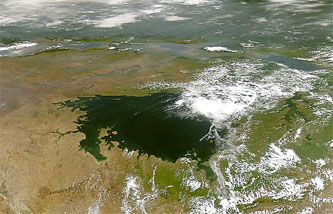Lake Victoria illegally drained for electricity in Uganda
mongabay.com
February 8, 2006
EDITOR’S NOTE: Lake Victoria, Africa’s largest freshwater lake, is being covertly drained for hydroelectric power according to an article published in the Feb. 11 New Scientist magazine. The report, written by Fred Pearce, says that Uganda is violating a 50-year-old international agreement designed to protect the lake. The following is a release from the New Scientist.
Uganda pulls plug on Lake Victoria
New Scientist Magazine
EAST Africa’s Lake Victoria, the world’s second largest freshwater lake, is being secretly drained to keep the lights on in Uganda. A report published this week says Uganda is flouting a 50-year-old international agreement designed to protect the lake’s waters.
Covering nearly 70,000 square kilometres, Lake Victoria takes a big bite out of surrounding Uganda, Kenya and Tanzania. An estimated 30 million people depend on it for their livelihoods. Since 2003, however, the lake has lost 75 cubic kilometres of water, about 3 per cent of its volume, leaving international ferries stranded far from their jetties, fishing boats mired in mud, and towns running low on water.
The only outlet for Lake Victoria, which is ringed by mountains, is at Jinja in Uganda, where it forms the Victoria Nile. Until 1954, the lake emptied into the Nile over a natural rock weir, but that year British colonial engineers blasted out the weir and replaced it with the Owens Falls dam, now renamed the Nalubaale dam, which effectively transformed the lake into a giant hydroelectric reservoir.
At the time, engineers agreed that the amount of water flowing through the dam’s turbines should mimic the old natural flow over the weir. The formula — known as the “agreed curve” — set a maximum flow of between 300 and 1700 cubic metres per second, depending on the water level in the lake. The agreed curve remains in force today under a treaty with Egypt, the ultimate user of most of the Nile’s water.
 Lake Victoria as seen just to the north of west across the lake. Image provided by the SeaWiFS Project, NASA/Goddard Space Flight Center, and ORBIMAGE. RELATED ARTICLE African lakes disappearing — UN survey |
In 2002, Uganda finished building a second hydropower complex close to the first one. Soon after its completion people began to notice the water level falling, and today the lake is at an 80-year low. In recent weeks, the operator of the two dams, the Uganda Electricity Generating Company, has blamed disruption of electricity supplies on low lake levels, ostensibly caused by the 10 to 15 per cent decline in rainfall across the lake’s catchment area during the past two years.
However, it now seems that the dams themselves are as much to blame as the recent drought. Daniel Kull, a hydrologist with the UN’s International Strategy for Disaster Reduction in Nairobi, Kenya, calculates that if the dams had been operated according to the agreed curve during the past two years, the drought would have caused only half the water loss actually seen. “Today’s lake levels would be around 45 centimetres higher,” he writes in a report released this week by the California-based environmental lobby group, International Rivers Network. Kull estimates that in the past two years, the Ugandan dams have released water at an average of almost 1250 cubic metres per second. That is 55 per cent more than the flow permitted for the relevant water levels. While Uganda does not routinely publish figures on the dams’ operations, Kull says sporadic official reports show that releases were nearly twice the permitted rates in both March and November 2005 — supporting his conclusion. “This dam complex is pulling the plug on Lake Victoria,” says Frank Muramuzi of Uganda’s National Association of Professional Environmentalists.
This is a modified news release from New Scientist.